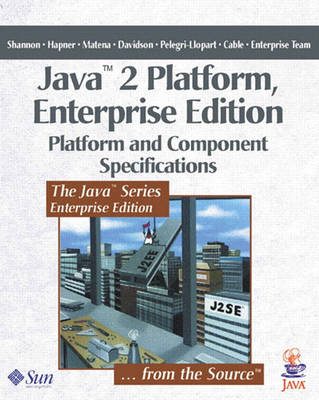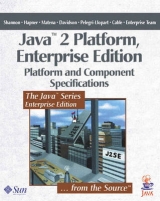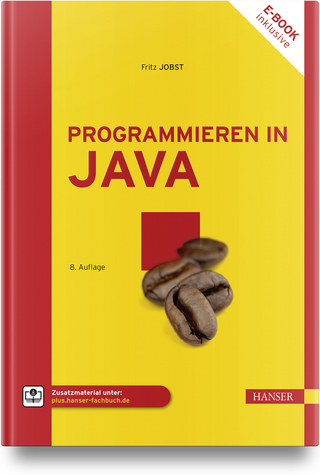Java™ 2 Platform, Enterprise Edition
Addison Wesley (Verlag)
978-0-201-70456-3 (ISBN)
- Titel ist leider vergriffen;
keine Neuauflage - Artikel merken
The newly-released Java TM 2 Platform Enterprise Edition (J2EE) is rapidly becoming the hottest technology for enterprise development. This complete, authoritative J2EE specification, direct from Sun Microsystems, is all developers need to know to deploy J2EE. Java 2 Enterprise Edition Specifications contains detailed coverage of the J2EE standard platform for application hosting; the new J2EE compatibility test suite; Sun's J2EE Reference Implementation; and the J2EE application model for developing multi-tier thin-client services. Every key element of J2EE is presented, including new technologies generating serious excitement amongst enterprise developers: servlets, JavaServer Pages, JNDI, and Enterprise JavaBeans. Coverage also includes security, JDBC, RMI-IIOP support, the Java Transaction API, interoperability issues, XML support, and more -- including a full chapter on the future of Java 2 Enterprise Edition.
Bill Shannon is a Distinguished Engineer at Sun Microsystems, where he is one of the architects of the J2EE. He previously worked on the JavaMail API, the HotJava Views product, the Common Desktop Environment, the Solaris operating system, and all versions of SunOS. Mark Hapner is Lead Architect for the Java 2 Platform, Enterprise Edition. He participated in the development of the JDBC API, wrote the Java Message Service specification, and co-authored the Enterprise JavaBeans specification. Vlada Matena is a co-founder of Lammina Systems Corporation where he designs a scalable Java platform for modular Linux servers. He was the originator and chief architect of Enterprise Java Beans and a founding member of the J2EE architecture team at Sun Microsystems, Inc. James Davidson is a Staff Engineer at Sun Microsystems, working on web server-related technologies. Before joining Sun, James was involved in building some of the very first e-commerce sites on the World Wide Web. Eduardo Pelegri-Llopart is the Web Layer Architect for the Java platform, coordinating technical efforts on the Servlet, JSP, and XML layers. He is also the co-spec lead for the JSP 1.0 and JSP 1.1. Larry Cable is a Senior Staff Engineer with Sun Microsystems where he is the lead architect for the iPlanet Application Server developed jointly by Sun and Netscape. 0201704560AB09232002
Foreword.
Java™ 2 Platform Enterprise Edition Specification, v1.2.
1. Introduction .
Acknowledgments.
2. Platform Overview.
Architecture.
Product Requirements.
Product Extensions.
Platform Roles.
Platform Contracts.
3. Security.
Introduction.
A Simple Example.
Security Architecture.
User Authentication Requirements.
Authorization Requirements.
Deployment Requirements.
Future Directions.
4. Transaction Management.
Overview.
Requirements.
Transaction Interoperability.
System Administration Tools.
5. Naming.
Overview.
Java Naming and Directory Interface™ (JNDI) Naming Context.
Enterprise JavaBeans™ (EJB) References.
Resource Factory References.
UserTransaction References.
6. Application Programming Interface.
Required APIs.
Java 2 Platform, Standard Edition (J2SE) Requirements.
JDBC™ 2.0 Standard Extension Requirements.
RMI-IIOP 1.0 Requirements.
Enterprise JavaBeans™ (EJB) 1.1 Requirements.
Servlet 2.2 Requirements.
JavaServer Pages™ (JSP) 1.1 Requirements.
Java™ Message Service (JMS) 1.0 Requirements.
Java Naming and Directory Interface™ (JNDI) 1.2 Requirements.
Java™ Transaction API (JTA) 1.0 Requirements.
JavaMail™ 1.1 Requirements.
JavaBeans™ Activation Framework 1.0 Requirements.
7. Interoperability.
Introduction to Interoperability.
Interoperability Protocols.
8. Application Assembly and Deployment.
Application Development Life Cycle.
Application Assembly.
Deployment.
J2EE: Application XML DTD.
9. Application Clients.
Overview.
Security.
Transactions.
Naming.
Application Programming Interfaces.
Packaging and Deployment.
J2EE: application-client XML DTD.
10. Service Provider Interface.
11. Future Directions.
Java™ Message Service API.
Enterprise JavaBeans™ (EJB)/IIOP Protocol.
J2EE SPI.
Connectors.
XML APIs.
JDBC RowSets.
Security APIs.
Deployment APIs.
Management APIs.
SQLJ Part.
A. Revision History.
Changes Since Public Draft.
Changes Since Public Release.
Changes Since Public Release.
B. Related Documents.
JAVA™ SERVLET SPECIFICATION, V2.2 (SRV).
Preface.
Who Should Read This Specification.
API Reference.
Other Java™ Platform Specifications.
Other Important References.
Providing Feedback.
Acknowledgments.
Overview.
What Is a Servlet?
What Is a Servlet Container?
An Example.
Comparing Servlets with Other Technologies.
Relationship to Java 2 Enterprise Edition.
Distributable Servlet Containers.
Changes Since Version 2.1.
2. Terms Used.
Basic Terms.
Roles.
Security Terms.
3 The Servlet Interface.
Request Handling Methods.
Number of Instances.
Servlet Life Cycle.
4. Servlet Context.
Scope of a ServletContext.
Initialization Parameters.
Context Attributes.
Resources.
Multiple Hosts and Servlet Contexts.
Reloading Considerations.
Temporary Working Directories.
5. The Request.
Parameters.
Attributes.
Headers.
Request Path Elements.
Path Translation Methods.
Cookies.
SSL Attributes.
Internationalization.
6. The Response.
Buffering.
Headers.
Convenience Methods.
Internationalization.
Closure of Response Object.
7. Sessions.
Session Tracking Mechanisms.
Creating a Session.
Session Scope.
Binding Attributes into a Session.
Session Timeouts.
Last Accessed Times.
Important Session Semantics.
8. Dispatching Requests.
Obtaining a RequestDispatcher.
Using a Request Dispatcher.
include.
forward.
Error Handling.
9. Web Applications.
Relationship to ServletContext.
Elements of a Web Application.
Distinction Between Representations.
Directory Structure.
Web Application Archive File.
Web Application Configuration Descriptor.
Replacing a Web Application.
Error Handling.
Web Application Environment.
10. Mapping Requests to Servlets.
Use of URL Paths.
Specification of Mappings.
11. Security.
Introduction.
Declarative Security.
Programmatic Security.
Roles .
Authentication.
Server Tracking of Authentication Information.
Specifying Security Constraints.
12. Application Programming Interface.
Package javax.servlet.
Package javax.servlet.http.
13. Deployment Descriptor.
Deployment Descriptor Elements.
DTD 196.
Examples.
14. Futures.
JavaServer Pages™ Specification, v1.1 (JSP).
Preface.
Who Should Read This Document.
Related Documents.
Acknowledgments.
1. Overview.
The JavaServer Pages™ Technology.
What Is a JSP Page?
Features in JSP 1.1.
Overview of JSP Page Semantics.
Web Applications.
Application Model.
2. Standard Syntax and Semantics.
General Syntax Rules.
Error Handling.
Comments.
Quoting and Escape Conventions.
Overview of Semantics.
Template Text Semantics.
Directives.
Implicit Objects.
The PageContext Object.
Scripting Elements.
Actions.
Tag Attribute Interpretation Semantics.
Standard Actions.
3. The JSP Container.
The JSP Page Model.
JSP Page Implementation Class.
Buffering.
Precompilation.
4 Scripting.
Overall Structure.
Declarations Section.
Initialization Section.
Main Section.
5. Tag Extensions.
Introduction.
Tag Library.
Tag Library Descriptor.
Tag Handlers.
Scripting Variables.
Cooperating Actions.
Validation.
Conventions and Other Issues.
6. JSP Technology Classes.
Package javax.servlet.jsp.
Package javax.servlet.jsp.tagext.
7. JSP Pages as XML Documents.
Why an XML Representation.
Document Type.
Directives.
Scripting Elements.
Actions.
Transforming a JSP Page into an XML Document.
DTD for the XML Document.
A. Examples.
Simple Examples.
A Set of SQL Tags.
B. Implementation Notes.
Delivering Localized Content.
Processing TagLib Directives.
Processing Tag Libraries.
Implementing Buffering.
C. Packaging JSP Pages.
A Very Simple JSP Page.
The JSP Page Packaged as Source in a WAR File.
The Servlet for the Compiled JSP Page.
The Web Application Descriptor.
The WAR for the Compiled JSP Page.
D. Future.
Meta-Tag Information.
Standard Tags.
Additional Application Support.
JSP, XML, and XSL Technologies.
E. Changes.
Changes Between 1.1 PR2 and 1.1 Final.
Changes Between 1.1 PR1 and PR2.
Changes Between 1.1 PD1 and PR1.
Changes Between 1.0 and 1.1 PD1.
Enterprise JavaBeans™ Specification, v1.1 (EJB).
1. Introduction.
Target Audience.
What Is New in EJB 1.1.
Application Compatibility and Interoperability.
Acknowledgments.
Organization.
Document Conventions.
2. Goals.
Overall Goals.
Goals for Release 1.0.
Goals for Release 1.1.
3. EJB Architecture Roles and Scenarios.
EJB Architecture Roles.
Scenario: Development, Assembly, and Deployment.
4. Overview.
Enterprise Beans as Components.
Enterprise JavaBeans Architecture Contracts.
Session and Entity Objects.
Standard Mapping to CORBA Protocols.
5. Client View of a Session Bean.
Overview.
EJB Container.
Home Interface.
EJBObject.
Session Object Identity.
Client View of Session Object's Life Cycle.
Creating and Using a Session Object.
Object Identity.
Type Narrowing.
6 Session Bean Component Contract.
Overview.
Goals.
A Container's Management of Its Working Set.
Conversational State.
Protocol Between a Session Bean Instance and Its Container.
Stateful Session Bean State Diagram.
Object Interaction Diagrams for a Stateful Session Bean.
Stateless Session Beans.
Object Interaction Diagrams for a Stateless Session Bean.
The Responsibilities of the Bean Provider.
The Responsibilities of the Container Provider.
7. Example Session Scenario.
Overview.
Inheritance Relationship.
8. Client View of an Entity.
Overview.
EJB Container.
Entity Bean's Home Interface.
Entity Object's Life Cycle.
Primary Key and Object Identity.
Entity Bean's Remote Interface.
Entity Bean's Handle.
Entity Home Handles.
Type Narrowing of Object References.
9. Entity Bean Component Contract.
Concepts.
Responsibilities of the Enterprise Bean Provider.
The Responsibilities of the Container Provider.
Entity Beans with Container-Managed Persistence.
Object Interaction Diagrams.
10. Example Entity Scenario.
Overview.
Inheritance Relationship (Figure EBJ.10-1).
11. Support for Transactions.
Overview.
Sample Scenarios.
Bean Provider's Responsibilities.
Application Assembler's Responsibilities.
Deployer's Responsibilities.
Container Provider Responsibilities.
Access from Multiple Clients in the Same Transaction Context.
12. Exception Handling.
Overview and Concepts.
Bean Provider's Responsibilities.
Container Provider Responsibilities.
Client's View of Exceptions.
System Administrator's Responsibilities.
Differences from EJB 1.0.
13. Support for Distribution.
Overview.
Client-Side Objects in Distributed Environment.
Standard Distribution Protocol.
14. Enterprise Bean Environment.
Overview.
Bean Environment as JNDI API Naming Context.
EJB References.
Resource Manager Connection Factory References.
Deprecated EJBContext.getEnvironment() Method.
UserTransaction Interface.
15. Security Management.
Overview.
Bean Provider's Responsibilities.
Application Assembler's Responsibilities.
Deployer's Responsibilities.
EJB Architecture Client Responsibilities.
EJB Container Provider's Responsibilities.
System Administrator's Responsibilities.
16. Deployment Descriptor.
Overview.
Bean Provider's Responsibilities.
Application Assembler's Responsibility.
Container Provider's Responsibilities.
Deployment Descriptor DTD.
Deployment Descriptor Example.
17. EJB JAR File.
Overview.
Deployment Descriptor.
Class Files.
ejb-client JAR File.
Deprecated in EJB 1.1.
18. Runtime Environment.
Bean Provider's Responsibilities.
Container Provider's Responsibility.
19. Responsibilities of EJB Architecture Roles.
Bean Provider's Responsibilities.
Application Assembler's Responsibilities.
EJB Container Provider's Responsibilities.
Deployer's Responsibilities.
System Administrator's Responsibilities.
Client Programmer's Responsibilities.
20. Enterprise JavaBeans™ API Reference.
Package javax.ejb.
Package javax.ejb.deployment.
21. Related Documents.
A. Features Deferred to Future Releases.
B. Frequently Asked Questions.
Client-Demarcated Transactions.
Inheritance.
Entities and Relationships.
Finder Methods for Entities with Container-Managed Persistence.
JDK 1.1 or Java.
javax.transaction.UserTransaction versus javax.jts.UserTransaction.
How to Obtain Database Connections.
Session Beans and Primary Key .
Copying of Parameters Required for EJB Calls within the Same JVM.
C. Revision History.
Changes Since Release 0.8.
Changes Since Release 0.9.
Changes Since Release 0.95.
Changes Since 1.0.
Changes Since @AHEADS = Draft.
Changes Since @AHEADS = Draft.
Changes Since Draft.
Changes Since Public Draft.
Changes Since Public Draft.
Changes Since Public Draft.
Changes Since Public Release.
Changes Since Public Release.
Glossary.
Index. 0201704560T04062001
| Erscheint lt. Verlag | 9.6.2000 |
|---|---|
| Verlagsort | Boston |
| Sprache | englisch |
| Maße | 190 x 235 mm |
| Gewicht | 1163 g |
| Themenwelt | Informatik ► Programmiersprachen / -werkzeuge ► Java |
| Mathematik / Informatik ► Informatik ► Web / Internet | |
| ISBN-10 | 0-201-70456-0 / 0201704560 |
| ISBN-13 | 978-0-201-70456-3 / 9780201704563 |
| Zustand | Neuware |
| Informationen gemäß Produktsicherheitsverordnung (GPSR) | |
| Haben Sie eine Frage zum Produkt? |
aus dem Bereich




